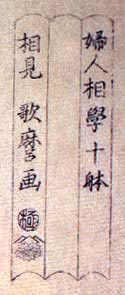

Kitagawa Utamaro and the PhysiognomistsThe Utamaro design used on this website to demonstrate the Stages of Printing was part of a significant group of at least 8 prints from the early 1790s. They were published in two separate sets with slightly different series titles in the right panel of the cartouche (see below). In all but two designs the subject subtitles were omitted from the center panel. Thus most of the compositions can only be identified descriptively, as in Popen o fuku musume ("Young woman blowing a popen"), the subject of our demonstration print. Popen is an onomatopoetic Japanese word for a toy made of blown glass with a hollow stem and a bowl at one end. (A popen looked like a small wine glass without a base). Formed with a thin membrane, it expanded when a person blew into the stem (this was done gently, however, as too much force would break the glass). When the popen was removed from the mouth, air escaped via the stem and the internal pressure dropped, causing the envelope of glass to contract quickly and make a popping sound. The popen was not a toy of native Japanese derivation, and was apparently first introduced through the port of Nagasaki, either by the Chinese or the Dutch, both importers of blown-glass objects into Japan. With her exotic foreign toy, Utamaro's beauty would have been considered by her contemporaries as particularly up-to-date with current fads, exhibiting what was called fûryû (elegance and style).
Utamaro's popen design appeared under both of the series titles. The first to be issued was most likely Fujin sôgaku juttai ("Study of the physiognomy of ten types of women"), with the signature Sômi Utamaro ga ("Drawn by the physiognomist Utamaro"). The second series was Fujo ninsô juppon ("Ten classes of women's facial types"), with the signature Sôkan Utamaro kôga ("Thoughtfully drawn by Utamaro the physiognomist"). Scholars have attempted to provide convincing reasons for why the publisher Tsutaya Jûzaburô (his mark appears at the bottom of the left panel) issued Utamaro's popen design under two separate series titles, and why he then followed with other designs that were apparently produced only under the second series title. As noted earlier, only two designs from the earlier set bear subtitles in the middle panel of the cartouche (they describe the personalities of the women), whereas other designs from that set, including popen, and all from the later set (including the reissue of popen) do not have subtitles. One explanation (Asano and Clark, see reference below) involves the word sôgaku (study of physiognomy) in the first series title, which when used by an untrained, non-professional sômi (physiognomist) such as Utamaro could possibly have offended the true professionals or even risked reprisals by the gyôji (publishing guild representatives or "judges" who censored books and prints; their kiwame seal, meaning "approved," appears above Jûzaburô's mark in the left panel). Perhaps when accompanied by sôgaku in the series title, the explicit inclusion of personality types in subtitles proved too much for the sômi. In addition, sômi in the original signature was replaced in the second series by the generic and possibly less offensive term sôkan (both terms mean more or less the same thing). The term sômi can be taken literally to mean "looking at the face" — a designation for professional physiognomists who interpreted (mi, viewed or perceived) a person’s face (sô, countenance or physiognomy). Sômi offered their clients helpful counsel based on the belief that people exhibited distinct personality types through their physiognomies. Some sômi used the divinatory "Book of Changes" as a general guide. Utamaro's playful, fashionable beauty and the other women depicted in these two series were among the earliest examples of half-length close-ups of women placed against mica backgrounds, probably dating from circa 1792-93. Regardless of the exalted status of these striking compositions in the development of ukiyo-e printmaking, Utamaro's brand of physiognomy was not equivalent to what we in the West would consider true likenesses or portraiture. Utamaro and his contemporaries depicted their women according to typologies or idealized forms — their faces did not look literally as they do in the prints (see also the comparison in physiognomies between Goyô and Utamaro). © 2002-2019 by John Fiorillo For more about Utamaro, see Utamaro's Tragic Lovers. BIBLIOGRAPHY
|
Viewing Japanese Prints |


